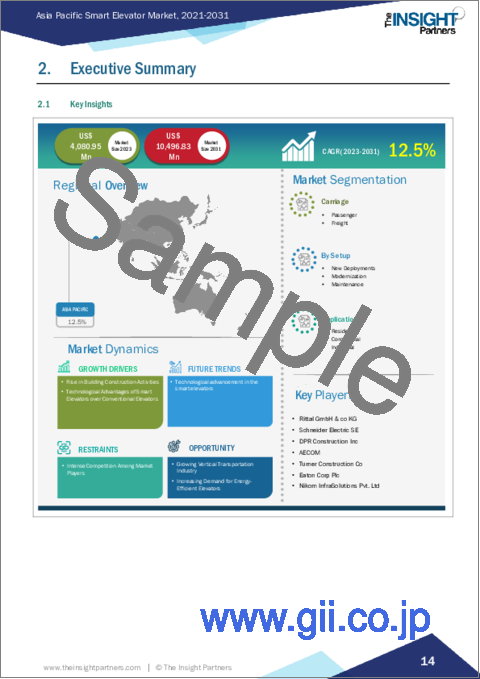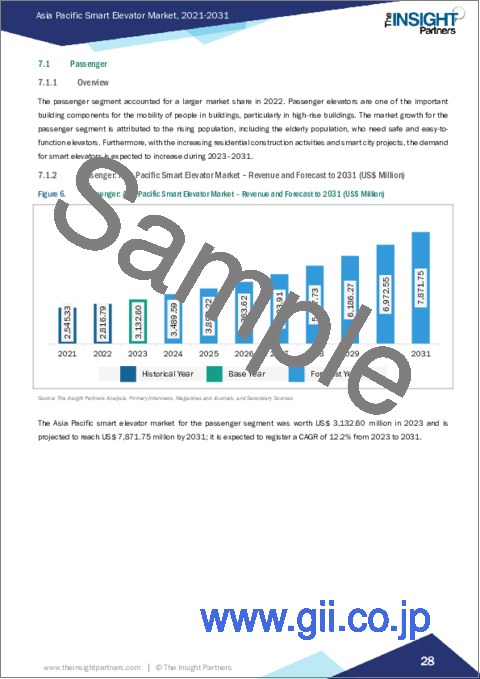|
|
市場調査レポート
商品コード
1597163
アジア太平洋のスマートエレベーター市場:2031年までの予測 - 地域別分析 - セットアップ別、運搬別、用途別Asia Pacific Smart Elevator Market Forecast to 2031 - Regional Analysis - by Setup (Modernization, Maintenance, and New Deployments), Carriage (Passenger and Freight), and Application (Residential, Commercial, and Industrial) |
||||||
|
|||||||
| アジア太平洋のスマートエレベーター市場:2031年までの予測 - 地域別分析 - セットアップ別、運搬別、用途別 |
|
出版日: 2024年10月17日
発行: The Insight Partners
ページ情報: 英文 99 Pages
納期: 即納可能
|
全表示
- 概要
- 図表
- 目次
アジア太平洋のスマートエレベーター市場は、2023年に40億8,095万米ドルとなり、2031年までには104億9,683万米ドルに達すると予測され、2023年から2031年までのCAGRは12.5%と推定されます。
従来型エレベーターに対するスマートエレベーターの技術的優位性がアジア太平洋のスマートエレベーター市場を押し上げる
従来のエレベーターの基本的な演算能力では、利用者の待ち時間を短縮することはできません。さらに、最新のエレベーターに比べてエネルギー効率が悪く、エレベーター・システムのリアルタイム監視もできません。しかし、スマートエレベーターは技術的に先進的であり、様々な機能を備えているため、建築請負業者による選好が高まっています。これらのエレベーターに自律システムを採用することで、エレベーターの動作を最適化することができ、ひいては待ち時間の短縮につながり、最終的には混雑時の効率的な乗客輸送につながります。
タッチスクリーン・インターフェイス、音声コマンド、ジェスチャー・コントロール、モバイル・アプリの操作性といったスマートエレベーターの特徴は、エレベーターをより使いやすくし、乗客の快適性を高めます。スマートエレベーターは、運転データをリアルタイムでクラウドに送信し、認定を受けた従業員がいつでもアクセスできるため、あらゆる問題のタイムリーな解決が容易になります。従来のエレベーターとは対照的に、スマートエレベーターは、顔認証、生体認証、その他の技術など、不正アクセスを避けるための先進的なセキュリティ対策を採用しています。さらに、これらのエレベーターは、過度の振動や電気系統の故障など、エレベーターの不規則な挙動を継続的に監視するセンサーやその他のシステムを統合しています。
さらに、絶えず変化する技術情勢の結果、顧客はエレベーター・システムに革新的でより最先端の機能を求めています。エネルギー効率、省スペース、時間効率、長寿命、手頃な価格、低メンテナンス、安全性などはすべて、最新のエレベーターのメリットです。上記のような利点があるため、従来のエレベーターよりもスマートエレベーターの需要が高まっています。
アジア太平洋のスマートエレベーター市場概要
アジア太平洋の市場は、予測期間中に最も速いCAGRで成長すると予想されます。この成長の背景には、都市化の進展、政府の支援策、インフラプロジェクトへの投資の増加が考えられます。例えば、中国政府は2021年3月、今後半世紀の壮大な戦略的青写真である中国の第14次5ヵ年計画(FYP)(2021年~2025年)と2035年までの長期目標を承認しました。政府は、2025年までに中国の都市化率を人口の65%にまで引き上げ、2035年までに先進国並みの75%を達成するとしています。より多くの人々が農村部から都市部へ移動するにつれて、インフラ建設への投資がより重視されるようになります。
Insight Partnerの分析によると、世界人口の約60%がアジア太平洋に住んでおり、中でも中国とインドが最も人口の多い国です。20億人以上が都市部に住んでいます。このため、新築ビルや古いビルを高層住宅に改築する需要が急増しています。また、同地域のいくつかの都市はハイテク産業の中心地となっており、同地域に進出する企業の数が増加しているため、新しい商業ビルの建設や古いビルの改築が進んでいます。こうした理由から、住宅や商業ビルでエレベーターを利用する人々や従業員の数は非常に増加しており、既存のエレベーターを技術的に優れた、より安全で、より大きく、より高速なものに近代化することにつながっています。そのため、アジア太平洋では予測期間中にスマートエレベーターの需要が増加すると予想されます。
アジア太平洋のスマートエレベーター市場の収益と2031年までの予測(金額)
アジア太平洋のスマートエレベーター市場のセグメンテーション
アジア太平洋のスマートエレベーター市場は、運搬、セットアップ、用途、国に基づいてセグメント化されます。
運搬別では、アジア太平洋のスマートエレベーター市場は旅客と貨物に二分されます。2023年には旅客セグメントがより大きなシェアを占めています。
セットアップに基づくと、アジア太平洋のスマートエレベーター市場は近代化、メンテナンス、新規導入に区分されます。新規導入セグメントが2023年に最大のシェアを占めました。
用途別では、アジア太平洋のスマートエレベーター市場は、住宅、商業、工業に区分されます。2023年には商業セグメントが最大のシェアを占めました。
国別では、アジア太平洋のスマートエレベーター市場は、オーストラリア、中国、インド、日本、韓国、その他アジア太平洋に分類されます。中国が2023年のアジア太平洋のスマートエレベーター市場を独占しました。
Fujitec Co Ltd、Otis Worldwide Corp、Kone Corp、Hyundai Elevator Co Ltd、Thyssen Krupp AG、Schindler Holding AG、Mitsubishi Electric Corp、Hitachi Ltd、Toshiba Elevator and Building Systems Corporation、Smart Plus Elevator Pvt. Ltd.は、アジア太平洋のスマートエレベーター市場で事業を展開している主要企業です。
目次
第1章 イントロダクション
第2章 エグゼクティブサマリー
- 主要洞察
- 市場の魅力
第3章 調査手法
- 調査範囲
- 2次調査
- 1次調査
第4章 アジア太平洋のスマートエレベーター市場情勢
- エコシステム分析
- バリューチェーンのベンダー一覧
第5章 アジア太平洋のスマートエレベーター市場:主要市場力学
- アジア太平洋のスマートエレベーター市場:主な市場力学
- 市場促進要因
- ビル建設活動の活発化
- 従来型エレベーターに対するスマートエレベーターの技術的優位性
- 市場抑制要因
- 市場競合の激化
- 市場機会
- 垂直輸送産業の成長
- エネルギー効率の高いエレベーターへの需要の高まり
- 今後の動向
- エレベーター産業における技術の進歩
- 促進要因と抑制要因の影響
第6章 スマートエレベーター市場:アジア太平洋市場分析
- アジア太平洋のスマートエレベーター市場収益、2023年~2031年
- アジア太平洋のスマートエレベーター市場予測分析
第7章 アジア太平洋のスマートエレベーター市場分析:運搬別
- 旅客
- 貨物
第8章 アジア太平洋のスマートエレベーター市場分析:セットアップ別
- 新規導入
- 近代化
- メンテナンス
第9章 アジア太平洋のスマートエレベーター市場分析:用途別
- 住宅用
- 商業用
- 産業用
第10章 アジア太平洋のスマートエレベーター市場:国別分析
- アジア太平洋
- 中国
- インド
- 日本
- オーストラリア
- 韓国
- その他アジア太平洋
第11章 競合情勢
- 企業のポジショニングと集中度
- ヒートマップ分析:主要企業別
第12章 業界情勢
- 市場イニシアティブ
- 製品開発
- 合併・買収
第13章 企業プロファイル
- Fujitec Co Ltd
- Otis Worldwide Corp
- Kone Corp
- Hyundai Elevator Co Ltd
- ThyssenKrupp AG
- Schindler Holding AG
- Mitsubishi Electric Corp
- Hitachi Ltd
- Toshiba Elevator and Building Systems Corporation
- Smart Plus Elevator Pvt. Ltd.
第14章 付録
List Of Tables
- Table 1. Asia Pacific Smart Elevator Market segmentation
- Table 2. List of Vendors
- Table 3. Asia Pacific Smart Elevator Market - Revenue and Forecast to 2031 (US$ Million)
- Table 4. Asia Pacific Smart Elevator Market - Revenue and Forecast to 2031 (US$ Million) - by Carriage
- Table 5. Asia Pacific Smart Elevator Market - Revenue and Forecast to 2031 (US$ Million) - by Setup
- Table 6. Asia Pacific Smart Elevator Market - Revenue and Forecast to 2031 (US$ Million) - by Application
- Table 7. Asia Pacific: Smart Elevator Market - Revenue and Forecast to 2031(US$ Million) - by Country
- Table 8. China: Smart Elevator Market - Revenue and Forecast to 2031(US$ Million) - by Carriage
- Table 9. China: Smart Elevator Market - Revenue and Forecast to 2031(US$ Million) - by Setup
- Table 10. China: Smart Elevator Market - Revenue and Forecast to 2031(US$ Million) - by Application
- Table 11. India: Smart Elevator Market - Revenue and Forecast to 2031(US$ Million) - by Carriage
- Table 12. India: Smart Elevator Market - Revenue and Forecast to 2031(US$ Million) - by Setup
- Table 13. India: Smart Elevator Market - Revenue and Forecast to 2031(US$ Million) - by Application
- Table 14. Japan: Smart Elevator Market - Revenue and Forecast to 2031(US$ Million) - by Carriage
- Table 15. Japan: Smart Elevator Market - Revenue and Forecast to 2031(US$ Million) - by Setup
- Table 16. Japan: Smart Elevator Market - Revenue and Forecast to 2031(US$ Million) - by Application
- Table 17. Australia: Smart Elevator Market - Revenue and Forecast to 2031(US$ Million) - by Carriage
- Table 18. Australia: Smart Elevator Market - Revenue and Forecast to 2031(US$ Million) - by Setup
- Table 19. Australia: Smart Elevator Market - Revenue and Forecast to 2031(US$ Million) - by Application
- Table 20. South Korea: Smart Elevator Market - Revenue and Forecast to 2031(US$ Million) - by Carriage
- Table 21. South Korea: Smart Elevator Market - Revenue and Forecast to 2031(US$ Million) - by Setup
- Table 22. South Korea: Smart Elevator Market - Revenue and Forecast to 2031(US$ Million) - by Application
- Table 23. Rest of Asia Pacific: Smart Elevator Market - Revenue and Forecast to 2031(US$ Million) - by Carriage
- Table 24. Rest of Asia Pacific: Smart Elevator Market - Revenue and Forecast to 2031(US$ Million) - by Setup
- Table 25. Rest of Asia Pacific: Smart Elevator Market - Revenue and Forecast to 2031(US$ Million) - by Application
- Table 26. Heat Map Analysis By Key Players
List Of Figures
- Figure 1. Asia Pacific Smart Elevator Market segmentation, by Country
- Figure 2. Ecosystem Analysis
- Figure 3. Impact Analysis of Drivers and Restraints
- Figure 4. Asia Pacific Smart Elevator Market Revenue (US$ Million), 2023-2031
- Figure 5. Asia Pacific Smart Elevator Market Share (%) - by Carriage (2023 and 2031)
- Figure 6. Passenger: Asia Pacific Smart Elevator Market - Revenue and Forecast to 2031 (US$ Million)
- Figure 7. Freight: Asia Pacific Smart Elevator Market - Revenue and Forecast to 2031 (US$ Million)
- Figure 8. Asia Pacific Smart Elevator Market Share (%) - by Setup (2023 and 2031)
- Figure 9. New Deployments: Asia Pacific Smart Elevator Market - Revenue and Forecast to 2031 (US$ Million)
- Figure 10. Modernization: Asia Pacific Smart Elevator Market - Revenue and Forecast to 2031 (US$ Million)
- Figure 11. Maintenance: Asia Pacific Smart Elevator Market - Revenue and Forecast to 2031 (US$ Million)
- Figure 12. Asia Pacific Smart Elevator Market Share (%) - by Application (2023 and 2031)
- Figure 13. Residential: Asia Pacific Smart Elevator Market - Revenue and Forecast to 2031 (US$ Million)
- Figure 14. Commercial: Asia Pacific Smart Elevator Market - Revenue and Forecast to 2031 (US$ Million)
- Figure 15. Industrial: Asia Pacific Smart Elevator Market - Revenue and Forecast to 2031 (US$ Million)
- Figure 16. Asia Pacific Smart Elevator Market- Revenue by Key Countries 2023 (US$ Million)
- Figure 17. Asia Pacific: Smart Elevator Market Breakdown, by Key Countries, 2023 and 2031 (%)
- Figure 18. China: Smart Elevator Market - Revenue and Forecast to 2031(US$ Million)
- Figure 19. India: Smart Elevator Market - Revenue and Forecast to 2031(US$ Million)
- Figure 20. Japan: Smart Elevator Market - Revenue and Forecast to 2031(US$ Million)
- Figure 21. Australia: Smart Elevator Market - Revenue and Forecast to 2031(US$ Million)
- Figure 22. South Korea: Smart Elevator Market - Revenue and Forecast to 2031(US$ Million)
- Figure 23. Rest of Asia Pacific: Smart Elevator Market - Revenue and Forecast to 2031(US$ Million)
The Asia Pacific smart elevator market was valued at US$ 4,080.95 million in 2023 and is expected to reach US$ 10,496.83 million by 2031; it is estimated to register at a CAGR of 12.5% from 2023 to 2031.
Technological Advantages of Smart Elevators over Conventional Elevators Boost Asia Pacific Smart Elevator Market
Basic computing power of conventional elevators cannot reduce users' waiting time. Furthermore, they are not energy efficient compared to modern elevators and do not include real-time monitoring of the elevator system. However, smart elevators are technically advanced and have various functions that contribute to their rising preference by building contractors. The usage of autonomous systems in these elevators aids in optimizing elevator actions, which, in turn, helps lessen wait time, eventually leading to more effective passenger transportation during busy hours.
Features of smart elevators such as touch screen interface, voice commands, gesture control, and mobile app controllability make them more user-friendly and enhance the comfort of passengers. Smart elevators send operational data to the cloud in real time, where certified employees can access it anytime and facilitate the timely resolution of any problem. In contrast to traditional elevators, smart elevators use progressive security measures such as facial recognition, biometrics, and other technologies to avoid unauthorized access. Furthermore, these elevators integrate sensors and other systems that continually monitor the irregular behavior of elevators, which includes excessive vibration, electrical faults, and others.
Further, customers demand innovative and more cutting-edge features from elevator systems as a result of the continuously changing technological landscape. Energy efficiency, space saving, time efficiency, long lasting, affordability, low maintenance, and safety are all benefits for modern elevators. Owing to all the benefits mentioned above, the demand for smart elevators over conventional elevators is increasing.
Asia Pacific Smart Elevator Market Overview
The market in Asia Pacific is expected to grow at the fastest CAGR during the forecast period. This growth may be attributed to the growing urbanization, supportive government initiatives, and increasing investment in infrastructural projects. For instance, in March 2021, the government of China approved China's 14th Five-Year Plan (FYP) (2021-2025), the grand strategic blueprint for the next half-decade, and longer-term goals for 2035. The government anticipated to achieve China's urbanization rate round 65% of the population by 2025 and 75% that of an advanced economy by 2035. As more individuals move from rural to urban areas, the focus is more on investment in building infrastructure.
According to The Insight Partner analysis, ~60% of the world's population lives in Asia Pacific, with China and India being the most highly populated countries. More than 2 billion people live in urban areas. This surges the demand for new buildings as well as renovations of older buildings to high-rise residential towers. Also, several cities across the region are tech hubs, which increases the number of companies expanding to the region, leading to new commercial buildings and the reconstruction of older buildings into larger space areas. Owing to these reasons, the number of people and employees using the elevators in residential and commercial buildings is highly increasing, leading to the modernization of the existing elevators into technologically better, safer, larger, and speedier ones. Therefore, the demand for smart elevators is expected to increase in Asia Pacific during the forecast period.
Asia Pacific Smart Elevator Market Revenue and Forecast to 2031 (US$ Million)
Asia Pacific Smart Elevator Market Segmentation
The Asia Pacific smart elevator market is segmented based on carriage, setup, application, and country.
In terms of carriage, the Asia Pacific smart elevator market is bifurcated into passenger and freight. The passenger segment held a larger share in 2023.
Based on setup, the Asia Pacific smart elevator market is segmented into modernization, maintenance, and new deployments. The new deployments segment held the largest share in 2023.
By application, the Asia Pacific smart elevator market is segmented into residential, commercial, and industrial. The commercial segment held the largest share in 2023.
Based on country, the Asia Pacific smart elevator market is categorized into Australia, China, India, Japan, South Korea, and the Rest of Asia Pacific. China dominated the Asia Pacific smart elevator market in 2023.
Fujitec Co Ltd, Otis Worldwide Corp, Kone Corp, Hyundai Elevator Co Ltd, Thyssen Krupp AG, Schindler Holding AG, Mitsubishi Electric Corp, Hitachi Ltd, Toshiba Elevator and Building Systems Corporation, and Smart Plus Elevator Pvt. Ltd. are some of the leading companies operating in the Asia Pacific smart elevator market.
Table Of Contents
1. Introduction
- 1.1 The Insight Partners Research Report Guidance
- 1.2 Market Segmentation
2. Executive Summary
- 2.1 Key Insights
- 2.2 Market Attractiveness
3. Research Methodology
- 3.1 Coverage
- 3.2 Secondary Research
- 3.3 Primary Research
4. Asia Pacific Smart Elevator Market Landscape
- 4.1 Overview
- 4.2 Ecosystem Analysis
- 4.2.1 List of Vendors in the Value Chain
5. Asia Pacific Smart Elevator Market - Key Market Dynamics
- 5.1 Asia Pacific Smart Elevator Market - Key Market Dynamics
- 5.2 Market Drivers
- 5.2.1 Rise in Building Construction Activities
- 5.2.2 Technological Advantages of Smart Elevators over Conventional Elevators
- 5.3 Market Restraints
- 5.3.1 Intense Competition Among Market Players
- 5.4 Market Opportunities
- 5.4.1 Growing Vertical Transportation Industry
- 5.4.2 Increasing Demand for Energy-Efficient Elevators
- 5.5 Future Trends
- 5.5.1 Technological Advancements in Elevator Industry
- 5.6 Impact of Drivers and Restraints:
6. Smart Elevator Market - Asia Pacific Market Analysis
- 6.1 Asia Pacific Smart Elevator Market Revenue (US$ Million), 2023-2031
- 6.2 Asia Pacific Smart Elevator Market Forecast Analysis
7. Asia Pacific Smart Elevator Market Analysis - by Carriage
- 7.1 Passenger
- 7.1.1 Overview
- 7.1.2 Passenger: Asia Pacific Smart Elevator Market - Revenue and Forecast to 2031 (US$ Million)
- 7.2 Freight
- 7.2.1 Overview
- 7.2.2 Freight: Asia Pacific Smart Elevator Market - Revenue and Forecast to 2031 (US$ Million)
8. Asia Pacific Smart Elevator Market Analysis - by Setup
- 8.1 New Deployments
- 8.1.1 Overview
- 8.1.2 New Deployments: Asia Pacific Smart Elevator Market - Revenue and Forecast to 2031 (US$ Million)
- 8.2 Modernization
- 8.2.1 Overview
- 8.2.2 Modernization: Asia Pacific Smart Elevator Market - Revenue and Forecast to 2031 (US$ Million)
- 8.3 Maintenance
- 8.3.1 Overview
- 8.3.2 Maintenance: Asia Pacific Smart Elevator Market - Revenue and Forecast to 2031 (US$ Million)
9. Asia Pacific Smart Elevator Market Analysis - by Application
- 9.1 Residential
- 9.1.1 Overview
- 9.1.2 Residential: Asia Pacific Smart Elevator Market - Revenue and Forecast to 2031 (US$ Million)
- 9.2 Commercial
- 9.2.1 Overview
- 9.2.2 Commercial: Asia Pacific Smart Elevator Market - Revenue and Forecast to 2031 (US$ Million)
- 9.3 Industrial
- 9.3.1 Overview
- 9.3.2 Industrial: Asia Pacific Smart Elevator Market - Revenue and Forecast to 2031 (US$ Million)
10. Asia Pacific Smart Elevator Market - Country Analysis
- 10.1 Asia Pacific
- 10.1.1 Asia Pacific: Smart Elevator Market - Revenue and Forecast Analysis - by Country
- 10.1.1.1 Asia Pacific: Smart Elevator Market - Revenue and Forecast Analysis - by Country
- 10.1.1.2 China: Smart Elevator Market - Revenue and Forecast to 2031 (US$ Million)
- 10.1.1.2.1 China: Smart Elevator Market Breakdown, by Carriage
- 10.1.1.2.2 China: Smart Elevator Market Breakdown, by Setup
- 10.1.1.2.3 China: Smart Elevator Market Breakdown, by Application
- 10.1.1.3 India: Smart Elevator Market - Revenue and Forecast to 2031 (US$ Million)
- 10.1.1.3.1 India: Smart Elevator Market Breakdown, by Carriage
- 10.1.1.3.2 India: Smart Elevator Market Breakdown, by Setup
- 10.1.1.3.3 India: Smart Elevator Market Breakdown, by Application
- 10.1.1.4 Japan: Smart Elevator Market - Revenue and Forecast to 2031 (US$ Million)
- 10.1.1.4.1 Japan: Smart Elevator Market Breakdown, by Carriage
- 10.1.1.4.2 Japan: Smart Elevator Market Breakdown, by Setup
- 10.1.1.4.3 Japan: Smart Elevator Market Breakdown, by Application
- 10.1.1.5 Australia: Smart Elevator Market - Revenue and Forecast to 2031 (US$ Million)
- 10.1.1.5.1 Australia: Smart Elevator Market Breakdown, by Carriage
- 10.1.1.5.2 Australia: Smart Elevator Market Breakdown, by Setup
- 10.1.1.5.3 Australia: Smart Elevator Market Breakdown, by Application
- 10.1.1.6 South Korea: Smart Elevator Market - Revenue and Forecast to 2031 (US$ Million)
- 10.1.1.6.1 South Korea: Smart Elevator Market Breakdown, by Carriage
- 10.1.1.6.2 South Korea: Smart Elevator Market Breakdown, by Setup
- 10.1.1.6.3 South Korea: Smart Elevator Market Breakdown, by Application
- 10.1.1.7 Rest of Asia Pacific: Smart Elevator Market - Revenue and Forecast to 2031 (US$ Million)
- 10.1.1.7.1 Rest of Asia Pacific: Smart Elevator Market Breakdown, by Carriage
- 10.1.1.7.2 Rest of Asia Pacific: Smart Elevator Market Breakdown, by Setup
- 10.1.1.7.3 Rest of Asia Pacific: Smart Elevator Market Breakdown, by Application
- 10.1.1 Asia Pacific: Smart Elevator Market - Revenue and Forecast Analysis - by Country
11. Competitive Landscape
- 11.1 Company Positioning & Concentration
- 11.2 Heat Map Analysis By Key Players
12. Industry Landscape
- 12.1 Overview
- 12.2 Market Initiative
- 12.3 Product Development
- 12.4 Mergers & Acquisitions
13. Company Profiles
- 13.1 Fujitec Co Ltd
- 13.1.1 Key Facts
- 13.1.2 Business Description
- 13.1.3 Products and Services
- 13.1.4 Financial Overview
- 13.1.5 SWOT Analysis
- 13.1.6 Key Developments
- 13.2 Otis Worldwide Corp
- 13.2.1 Key Facts
- 13.2.2 Business Description
- 13.2.3 Products and Services
- 13.2.4 Financial Overview
- 13.2.5 SWOT Analysis
- 13.2.6 Key Developments
- 13.3 Kone Corp
- 13.3.1 Key Facts
- 13.3.2 Business Description
- 13.3.3 Products and Services
- 13.3.4 Financial Overview
- 13.3.5 SWOT Analysis
- 13.3.6 Key Developments
- 13.4 Hyundai Elevator Co Ltd
- 13.4.1 Key Facts
- 13.4.2 Business Description
- 13.4.3 Products and Services
- 13.4.4 Financial Overview
- 13.4.5 SWOT Analysis
- 13.4.6 Key Developments
- 13.5 ThyssenKrupp AG
- 13.5.1 Key Facts
- 13.5.2 Business Description
- 13.5.3 Products and Services
- 13.5.4 Financial Overview
- 13.5.5 SWOT Analysis
- 13.5.6 Key Developments
- 13.6 Schindler Holding AG
- 13.6.1 Key Facts
- 13.6.2 Business Description
- 13.6.3 Products and Services
- 13.6.4 Financial Overview
- 13.6.5 SWOT Analysis
- 13.6.6 Key Developments
- 13.7 Mitsubishi Electric Corp
- 13.7.1 Key Facts
- 13.7.2 Business Description
- 13.7.3 Products and Services
- 13.7.4 Financial Overview
- 13.7.5 SWOT Analysis
- 13.7.6 Key Developments
- 13.8 Hitachi Ltd
- 13.8.1 Key Facts
- 13.8.2 Business Description
- 13.8.3 Products and Services
- 13.8.4 Financial Overview
- 13.8.5 SWOT Analysis
- 13.8.6 Key Developments
- 13.9 Toshiba Elevator and Building Systems Corporation
- 13.9.1 Key Facts
- 13.9.2 Business Description
- 13.9.3 Products and Services
- 13.9.4 Financial Overview
- 13.9.5 SWOT Analysis
- 13.9.6 Key Developments
- 13.10 Smart Plus Elevator Pvt. Ltd.
- 13.10.1 Key Facts
- 13.10.2 Business Description
- 13.10.3 Products and Services
- 13.10.4 Financial Overview
- 13.10.5 SWOT Analysis
- 13.10.6 Key Developments
14. Appendix
- 14.1 About The Insight Partners





